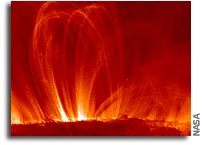NOAA SEC Space Weather Advisory Bulletin #03- 1

Official Space Weather Advisory issued by NOAA Space Environment Center
Boulder, Colorado, USA
SPACE WEATHER ADVISORY BULLETIN #03- 1
2003 May 29 at 02:00 p.m. MDT (2003 May 29 2000 UTC)
**** STRONG SOLAR FLARES AND GEOMAGNETIC STORM ****
Title: Major solar flares and Moderate to Strong geomagnetic storm
A recent series of three major flares have been observed on the Sun. All
of these flares have been from a complex sunspot region near the center
of the solar disk. The flare events all reached R3 level on the NOAA
radio blackout scale. The times of the flare events were 5:07 pm MDT on
27 May (27/2307 UTC), 6:27 pm MDT on 27 May (28/0027 UTC), and 6:47 pm
MDT on 28 May (29/0047 UTC). Strong solar wind has been observed in
response to the first two coronal mass ejections associated with the
first two flare events, with the first passage apparently around 5:55
am MDT on 29 May (29/1155 UTC) and the second around 12:30 pm MDT on 29
May (29/1830 UTC). The strong solar wind has increased geomagnetic
activity to strong levels (G3 on the NOAA scale). There is a good
chance that there will be additional periods of strong geomagnetic
activity during the next 24 hours. In addition to the current
disturbances in progress, a coronal mass ejection associated with the
third solar flare is likely to pass the earth sometime between midnight
and 6:00 am MDT on 30 May 2003, which should also add to the current
geomagnetic disturbance.
In addition, an S2 solar radiation storm is in progress in association
with the major flare activity.
G3 geomagnetic storms can lead to problems with electrical power systems
including the need for voltage corrections, and triggering of false
alarms on some protective devices. These storms also can affect
spacecraft operations including surface charging on satellite
components, increases in drag for low-Earth-orbit satellites, and
corrections for orientation problems. Additional effects include
intermittent satellite navigation and low-frequency radio navigation
problems, intermittent HF radio, and aurora as low as Illinois and
Oregon (typically 50° geomagnetic lat.).
R3 radio blackouts result in widespread HF radio communication outages
on the dayside of the Earth and can also degrade low frequency
navigation signals.
S2 solar radiation storms can lead to infrequent single-event upsets in
spacecraft operations, small effects on HF propagation through the
polar regions, possible small effects on navigation at polar cap
locations.
Data used to provide space weather services are contributed by NOAA,
USAF, NASA, NSF, USGS, the International Space Environment Services
and other observatories, universities, and institutions. For more
information, including email services, see SEC’s Space Weather
Advisories Web site http://sec.noaa.gov/advisories or (303) 497-5127.
The NOAA Public Affairs contact is Barbara McGehan at
Barbara.McGehan@noaa.gov or (303) 497-6288.








